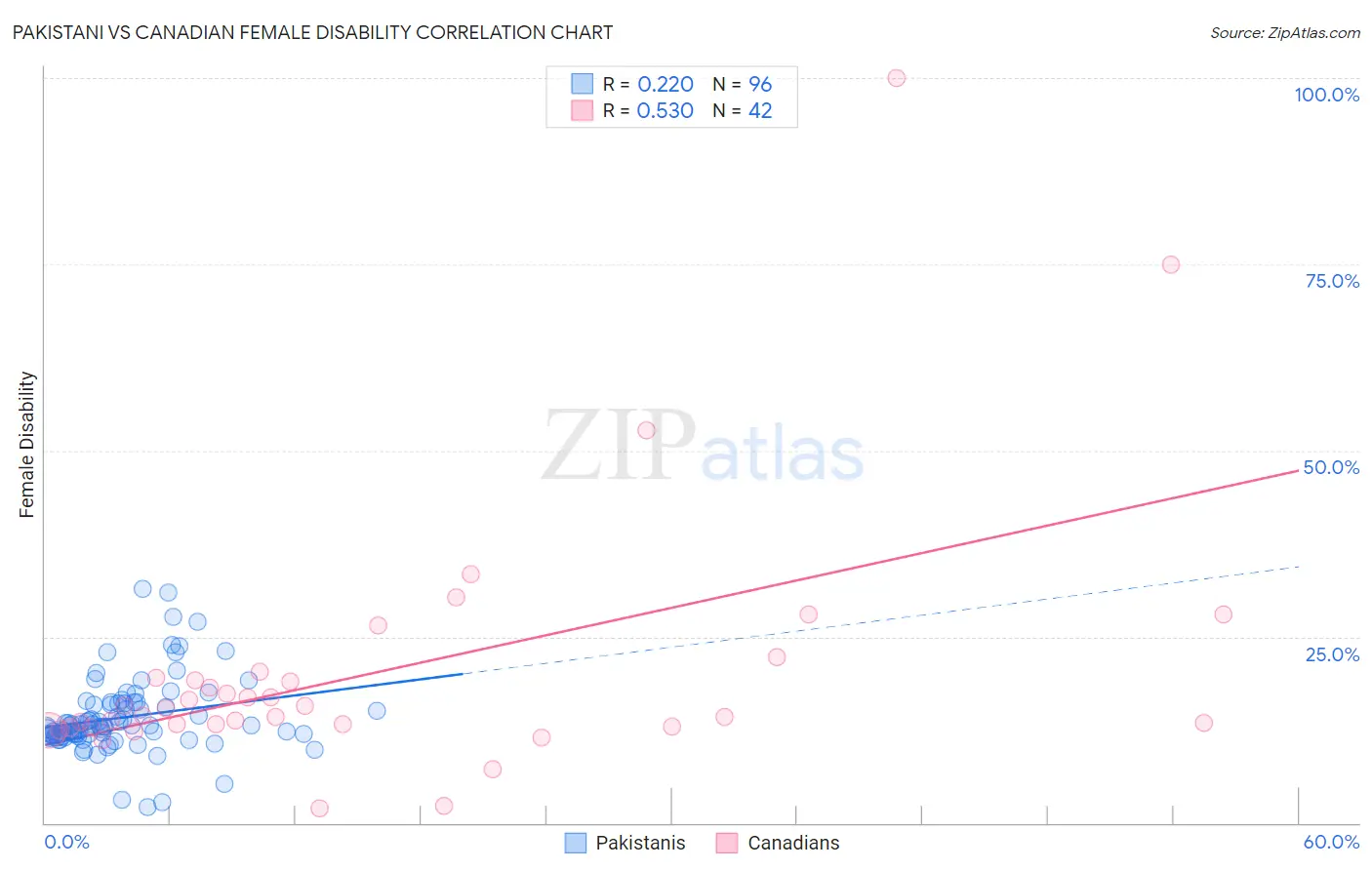Pakistani vs Canadian Female Disability
COMPARE
Pakistani
Canadian
Female Disability
Female Disability Comparison
Pakistanis
Canadians
12.0%
FEMALE DISABILITY
84.6/ 100
METRIC RATING
146th/ 347
METRIC RANK
12.6%
FEMALE DISABILITY
2.6/ 100
METRIC RATING
242nd/ 347
METRIC RANK
Pakistani vs Canadian Female Disability Correlation Chart
The statistical analysis conducted on geographies consisting of 335,294,894 people shows a weak positive correlation between the proportion of Pakistanis and percentage of females with a disability in the United States with a correlation coefficient (R) of 0.220 and weighted average of 12.0%. Similarly, the statistical analysis conducted on geographies consisting of 437,475,870 people shows a substantial positive correlation between the proportion of Canadians and percentage of females with a disability in the United States with a correlation coefficient (R) of 0.530 and weighted average of 12.6%, a difference of 5.1%.

Female Disability Correlation Summary
| Measurement | Pakistani | Canadian |
| Minimum | 2.2% | 2.0% |
| Maximum | 31.5% | 100.0% |
| Range | 29.3% | 98.0% |
| Mean | 14.2% | 20.3% |
| Median | 13.0% | 14.9% |
| Interquartile 25% (IQ1) | 11.7% | 12.9% |
| Interquartile 75% (IQ3) | 16.0% | 19.4% |
| Interquartile Range (IQR) | 4.3% | 6.5% |
| Standard Deviation (Sample) | 5.0% | 17.6% |
| Standard Deviation (Population) | 5.0% | 17.4% |
Similar Demographics by Female Disability
Demographics Similar to Pakistanis by Female Disability
In terms of female disability, the demographic groups most similar to Pakistanis are Nigerian (12.0%, a difference of 0.040%), Immigrants from Kenya (12.0%, a difference of 0.11%), Greek (12.0%, a difference of 0.18%), Immigrants from Moldova (12.0%, a difference of 0.21%), and Estonian (12.0%, a difference of 0.26%).
| Demographics | Rating | Rank | Female Disability |
| Immigrants | Hungary | 92.8 /100 | #139 | Exceptional 11.9% |
| Romanians | 91.6 /100 | #140 | Exceptional 11.9% |
| Immigrants | Ecuador | 91.5 /100 | #141 | Exceptional 11.9% |
| Immigrants | Africa | 90.0 /100 | #142 | Excellent 11.9% |
| Immigrants | Sudan | 89.6 /100 | #143 | Excellent 11.9% |
| Immigrants | Austria | 87.9 /100 | #144 | Excellent 12.0% |
| Estonians | 87.8 /100 | #145 | Excellent 12.0% |
| Pakistanis | 84.6 /100 | #146 | Excellent 12.0% |
| Nigerians | 84.0 /100 | #147 | Excellent 12.0% |
| Immigrants | Kenya | 83.1 /100 | #148 | Excellent 12.0% |
| Greeks | 82.0 /100 | #149 | Excellent 12.0% |
| Immigrants | Moldova | 81.4 /100 | #150 | Excellent 12.0% |
| Icelanders | 80.7 /100 | #151 | Excellent 12.0% |
| Immigrants | Scotland | 79.3 /100 | #152 | Good 12.0% |
| Sudanese | 79.1 /100 | #153 | Good 12.0% |
Demographics Similar to Canadians by Female Disability
In terms of female disability, the demographic groups most similar to Canadians are Immigrants from Senegal (12.6%, a difference of 0.010%), Alsatian (12.6%, a difference of 0.020%), Japanese (12.6%, a difference of 0.050%), Immigrants from Jamaica (12.6%, a difference of 0.16%), and Spanish American Indian (12.6%, a difference of 0.18%).
| Demographics | Rating | Rank | Female Disability |
| Malaysians | 5.0 /100 | #235 | Tragic 12.5% |
| Immigrants | West Indies | 4.4 /100 | #236 | Tragic 12.6% |
| Slavs | 3.8 /100 | #237 | Tragic 12.6% |
| Yugoslavians | 3.7 /100 | #238 | Tragic 12.6% |
| Barbadians | 3.6 /100 | #239 | Tragic 12.6% |
| German Russians | 3.2 /100 | #240 | Tragic 12.6% |
| Japanese | 2.7 /100 | #241 | Tragic 12.6% |
| Canadians | 2.6 /100 | #242 | Tragic 12.6% |
| Immigrants | Senegal | 2.5 /100 | #243 | Tragic 12.6% |
| Alsatians | 2.5 /100 | #244 | Tragic 12.6% |
| Immigrants | Jamaica | 2.2 /100 | #245 | Tragic 12.6% |
| Spanish American Indians | 2.1 /100 | #246 | Tragic 12.6% |
| Menominee | 2.1 /100 | #247 | Tragic 12.6% |
| Carpatho Rusyns | 2.0 /100 | #248 | Tragic 12.6% |
| Immigrants | Congo | 1.8 /100 | #249 | Tragic 12.7% |